
The House of Medici was an Italian banking family and political dynasty that first consolidated power in the Republic of Florence under Cosimo de' Medici and his grandson Lorenzo "the Magnificent" during the first half of the 15th century. The family originated in the Mugello region of Tuscany, and prospered gradually in trade until it was able to fund the Medici Bank. This bank was the largest in Europe in the 1400s and facilitated the Medicis' rise to political power in Florence, although they officially remained citizens rather than monarchs until the 16th century.

Donato di Niccolò di Betto Bardi, known mononymously as Donatello, was an Italian sculptor of the Renaissance period. Born in Florence, he studied classical sculpture and used his knowledge to develop an Early Renaissance style of sculpture. He spent time in other cities, where he worked on commissions and taught others; his periods in Rome, Padua, and Siena introduced to other parts of Italy the techniques he had developed in the course of a long and productive career. His David was the first freestanding nude male sculpture since antiquity; like much of his work it was commissioned by the Medici family.
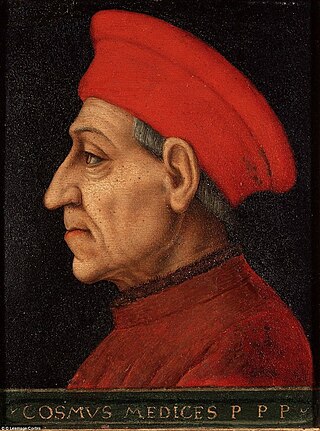
Cosimo di Giovanni de' Medici was an Italian banker and politician who established the Medici family as effective rulers of Florence during much of the Italian Renaissance. His power derived from his wealth as a banker and intermarriage with other rich and powerful families. He was a patron of arts, learning, and architecture. He spent over 600,000 gold florins on art and culture, including Donatello's David, the first freestanding nude male sculpture since antiquity.

The Republic of Florence, known officially as the Florentine Republic, was a medieval and early modern state that was centered on the Italian city of Florence in Tuscany, Italy. The republic originated in 1115, when the Florentine people rebelled against the Margraviate of Tuscany upon the death of Matilda of Tuscany, who controlled vast territories that included Florence. The Florentines formed a commune in his successors' place. The republic was ruled by a council known as the Signoria of Florence. The signoria was chosen by the gonfaloniere, who was elected every two months by Florentine guild members.
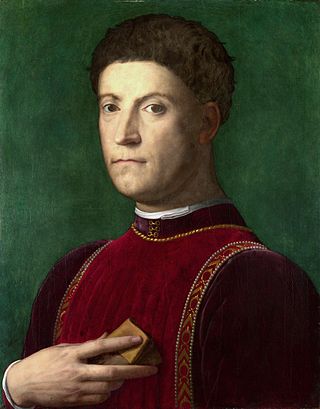
Piero di Cosimo de' Medici, known as Piero the Gouty, was the de facto ruler of Florence from 1464 to 1469, during the Italian Renaissance.

The Italian Renaissance was a period in Italian history between the 14th and 16th centuries. The period is known for the initial development of the broader Renaissance culture that spread across Western Europe and marked the transition from the Middle Ages to modernity. Proponents of a "long Renaissance" argue that it started around the year 1300 and lasted until about 1600. In some fields, a Proto-Renaissance, beginning around 1250, is typically accepted. The French word renaissance means "rebirth", and defines the period as one of cultural revival and renewed interest in classical antiquity after the centuries during what Renaissance humanists labelled as the "Dark Ages". The Italian Renaissance historian Giorgio Vasari used the term rinascita ("rebirth") in his Lives of the Most Excellent Painters, Sculptors, and Architects in 1550, but the concept became widespread only in the 19th century, after the work of scholars such as Jules Michelet and Jacob Burckhardt.

The Basilica di Santa Croce is a minor basilica and the principal Franciscan church of Florence, Italy. It is situated on the Piazza di Santa Croce, about 800 metres southeast of the Duomo, on what was once marshland beyond the city walls. Being the burial place of notable Italians, including those from the Italian Renaissance such as Michelangelo, Galileo, and Machiavelli, as well as the poet Foscolo, political philosopher Gentile and the composer Rossini, it is also known as the Temple of the Italian Glories.

Michelozzo di Bartolomeo Michelozzi, known mononymously as Michelozzo, was an Italian architect and sculptor. Considered one of the great pioneers of architecture during the Renaissance, Michelozzo was a favored Medici architect who was extensively employed by Cosimo de' Medici. He was a pupil of Lorenzo Ghiberti in his early years, and later collaborated with Donatello.
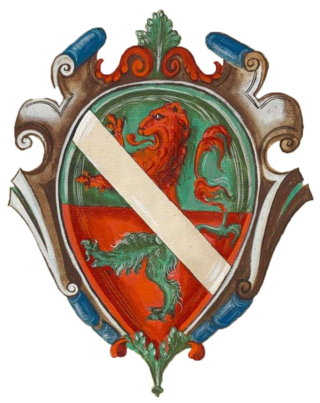
Jacopo Corsi was an Italian composer of the late Renaissance and early Baroque and one of Florence's leading patrons of the arts, after only the Medicis. His best-known work is Dafne (1597/98), whose score he wrote in collaboration with Jacopo Peri. Six fragments of the score have survived, two by Corsi and four by Peri. The libretto, by Ottavio Rinuccini, has survived intact. Despite priority quibbles at the time, Dafne is generally accepted as the first opera.
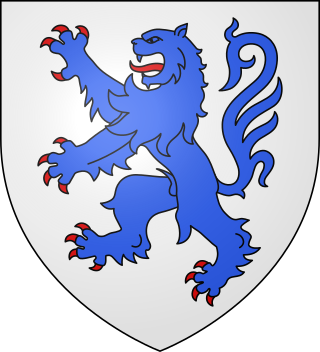
The Acciaioli family, also spelled Acciaiuoli, Accioly, Acciajuoli or Acioli was an important Italian noble family from Florence, whose members were the ruling Dukes of Athens.

Romola is a historical novel written between 1862 and 1863 by English author Mary Ann Evans under the pen name of George Eliot set in the fifteenth century. It is "a deep study of life in the city of Florence from an intellectual, artistic, religious, and social point of view". The story takes place amidst actual historical events during the Italian Renaissance, and includes in its plot several notable figures from Florentine history.

The Peruzzi family were bankers of Florence, among the leading families of the city in the 14th century, before the rise to prominence of the Medici. Their modest antecedents stretched back to the mid 11th century, according to the family's genealogist Luigi Passerini, but a restructuring of the Peruzzi company in 1300, with an infusion of outside capital, marked the start of a quarter-century of prosperity that brought the family consortium to the forefront of Florentine affairs.

The House of Strozzi is the name of an ancient Florentine family, who like their great rivals the House of Medici, began in banking before moving into politics. Until its exile from Florence in 1434, the Strozzi family was by far the richest in the city, and was rivaled only by the Medici family, who ultimately took control of the government and ruined the Strozzi both financially and politically. This political and financial competition was the origin of the Strozzi-Medici rivalry. Later, while the Medici ruled Florence, the Strozzi family ruled Siena, which Florence attacked, causing great animosity between the two families. Soon afterward, the Strozzi married into the Medici family, essentially giving the Medici superiority.
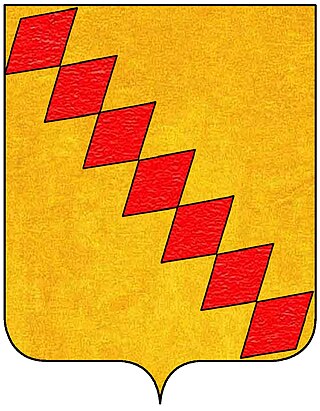
The House of Bardi was an influential Florentine family that started the powerful banking company Compagnia dei Bardi. In the 14th century the Bardis lent Edward III of England 900,000 gold florins, a debt which he failed to repay along with 600,000 florins borrowed from the Peruzzi family, leading to the collapse of both families' banks. During the 15th century the Bardi family continued to operate in various European centres, playing a notable role in financing some of the early voyages of discovery to America including those by Christopher Columbus and John Cabot.
A name in the Italian language consists of a given name and a surname ; in most contexts, the given name is written before the surname, although in official documents, the surname may be written before the given name or names.

Contessina de' Bardi, was an Italian noblewoman from the House of Bardi. Her marriage into the House of Medici provided her husband's family with much needed nobility, prestige, and military support as they established their power in Florence.

Gonfaloniere of Justice was a post in the government of medieval and early Renaissance Florence. Like Florence's Priori, it was introduced in 1293 when Giano Della Bella's Ordinances of Justice came into force.

The Marzocco is the heraldic lion that is a symbol of Florence, and was apparently the first piece of public secular sculpture commissioned by the Republic of Florence, in the late 14th century. The lion stood at the heart of the city in the Piazza della Signoria at the end of the platform attached to the Palazzo Vecchio called the ringhiera, from which speakers traditionally harangued the crowd. This is now lost, having weathered with time to an unrecognizable mass of stone.
Galluzzi is a surname most prevalent in the Italian regions Tuscany, Lombardy and Apulia. In Tuscany a toponymic origin of the name is suggested.
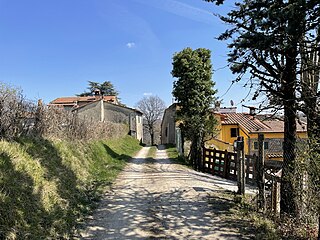
Mangona is a village in the municipality of Barberino di Mugello, in the metropolitan city of Florence, Italy. In the past it was the seat of the homonymous county, which took its name from the Castle of Mangona, now in ruins.



















